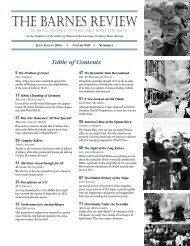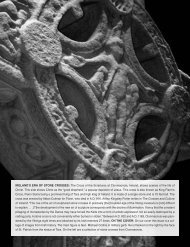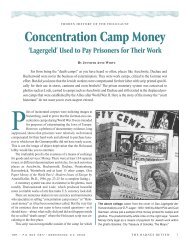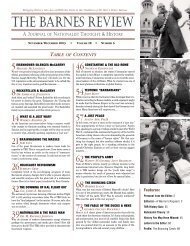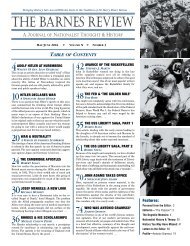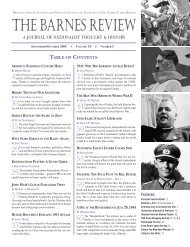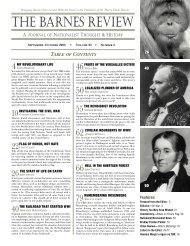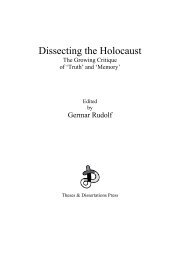Create successful ePaper yourself
Turn your PDF publications into a flip-book with our unique Google optimized e-Paper software.
PAGE 26 the barnes review MAY/JUNE<br />
dred from East Africa. <strong>The</strong> survey noted<br />
that up to one-third of the slaves had been<br />
captured in war, and another third had<br />
been kidnapped as children and sold into<br />
slavery. Of the remaining third, many had<br />
been sold by their parents or tribal elders<br />
and some were sentenced to slavery for<br />
some crime or another.<br />
Because Africans themselves conducted<br />
the African slave trade, Portuguese traders<br />
never ventured far from the coast. For four<br />
centuries after Diego Cao discovered the<br />
Congo River, European explorers did not<br />
even know where the river came from.<br />
Every slave in Africa was first enslaved<br />
by fellow Africans. Europeans had no part<br />
in choosing who was reduced to slavery.<br />
Most establishment historians who<br />
even mention the role of Africans<br />
themselves in the African slave trade<br />
mainly consider the intra-African slave<br />
trade as a monopoly of a powerful African<br />
tribal elite. This is not true, as slavery was<br />
so widespread in Africa that many individuals<br />
took part in the slave trade. Even<br />
though the slave trade in African states<br />
such as Ashante, Dahomey and Benin was<br />
controlled by an African elite, the meticulous<br />
records of Richard Miles indicate that<br />
many Africans took part in small scale<br />
trading to supplement their incomes.<br />
Richard Miles was an agent of the<br />
Company of Merchants, which succeeded<br />
the Royal Africa Company in 1750. Miles<br />
resided on the Gold Coast continuously<br />
from December 1772 until April 1780. <strong>The</strong><br />
records of Miles detailed every individual<br />
dealer from whom he bought slaves during<br />
his eight years on the Gold Coast. He purchased<br />
a total of 2,352 slaves during 1,308<br />
separate transactions. His deals were<br />
made with no fewer than 295 individuals,<br />
only 11 of whom sold slaves frequently. It<br />
appears from the record that any African<br />
who was able to acquire slaves did so<br />
whenever an opportunity arose. This pattern<br />
of individual Africans supplementing<br />
their income from the slave trade seems to<br />
be the established pattern as other British<br />
traders recognized a similar trend.<br />
<strong>The</strong> sub-Saharan African cultures were<br />
sub-literate, so the Africans themselves left<br />
no records for a modern historian to study.<br />
But at least one African leader named<br />
Antera Duke learned to write pidgin<br />
English and kept a diary in a ship’s logbook<br />
that he had been given by a British officer.<br />
Stephen Raper, who resides in Tennes see,<br />
is a longtime student of American and<br />
European Revisionist history.<br />
Duke sold slaves to ships calling at Old<br />
Calabar in eastern Nigeria and his diary<br />
records events from 1785 to 1788. His diary<br />
was eventually found by missionaries and<br />
taken to Scotland where it was later translated<br />
into Standard English. It should be<br />
noted that Duke was a member of the Efik<br />
tribe that occupied the islands of the Cross<br />
River estuary, close to the border between<br />
Nigeria and Cameroon. In the 18th century,<br />
the Efik were a major supplier of slaves<br />
and even their tribal name translates as<br />
“the oppressors.”<br />
Duke had sold slaves for nearly two<br />
decades before he began keeping his diary<br />
in 1785. His name appears in the ship<br />
records of an English ship, the Dobson,<br />
which stopped in Old Calabar in 1769.<br />
During the six months the Dobson was in<br />
Old Calabar, Duke sold a total of 37 slaves<br />
over the six-month period. By the time<br />
Duke had begun his diary in 1785, he was<br />
a very wealthy man, and his house was<br />
built of materials that had been imported<br />
to Africa from Liverpool, England. In his<br />
diary he notes more than 20 ships entered<br />
Old Calabar and left with more than 7,000<br />
slaves. Duke rarely mentioned his own contributions<br />
to these numbers but did write<br />
extensively on the African treatment of<br />
slaves. In fact Duke wrote extensively<br />
about the practice of the Efik sacrificing<br />
slaves during numerous rituals.<br />
<strong>The</strong> Efik practiced witchcraft and sorcery.<br />
<strong>The</strong>se practices led to torture<br />
and human sacrifices, which were thought<br />
to placate their gods and ancestors. Slaves<br />
were also allowed the “honor” of accompanying<br />
departed members of the Efik tribe<br />
on their journey into the afterlife. In July<br />
1786 when a prominent member of the<br />
tribe departed, Duke mentioned that “nine<br />
men and women went with him.” Four<br />
months later Duke wrote “we got ready to<br />
cut heads off and at 5 o’clock in the morning<br />
we began to cut slaves’ heads off, 50<br />
heads off in that one day.” Two days later<br />
Duke mentions sacrificing four more<br />
slaves, and three of these were sacrificed<br />
be cause a European ship arrived in harbor.<br />
In the language of Duke’s diary, there is no<br />
embarrassment or guilt over either the sacrifices<br />
or the selling of the slaves.<br />
<strong>The</strong> Efik were not the only African tribe<br />
that engaged in human sacrifice. <strong>The</strong> king<br />
of Dahomey was not only believed to have<br />
sold his own people into slavery, but sacrificed<br />
hundreds of them in an average year.<br />
<strong>The</strong> British consul to the Dahomean court<br />
in 1663, Richard Burton, stated that nocturnal<br />
sacrifices were a normal part of life<br />
and that the annual destruction of human<br />
life was “terribly great.” During one night<br />
Burton estimated that 80 men and women<br />
were sacrificed and that on the average the<br />
Dahomean kingdom sacrificed about 500<br />
slaves during the course of events in a normal<br />
year. Burton also stated that during<br />
years with grand ceremonies, upwards of<br />
1,000 slaves might be sacrificed.<br />
<strong>The</strong>re were also other kingdoms in<br />
which human sacrifice took place. <strong>The</strong><br />
Ashante, in what is now Ghana, also sacrificed<br />
their own slaves on special occasions.<br />
Many slaves would be sacrificed in the<br />
African kingdoms on the death of a king.<br />
Still more slaves would be sacrificed in the<br />
normal course of events. Whenever an<br />
African village suspected that witchcraft or<br />
sorcery was being practiced, they had a<br />
tendency to put all the suspects to death<br />
regardless of guilt or innocence. In some<br />
kingdoms, when the king had some piece of<br />
information he wanted to pass on to his<br />
departed ancestors, he would whisper the<br />
information into the ear of a slave who<br />
would then be immediately put to death.<br />
But the fascination with African tribal<br />
customs of human sacrifice was al -<br />
ways of a secondary interest to the Euro -<br />
pean powers. Originally Europeans were<br />
interested in Africa because of commercial<br />
aspects. But after the Europeans became<br />
aware of the grisly barbarism that the<br />
Africans practiced, the European states be -<br />
came more and more convinced of the mission<br />
Christianity had to play in civilizing<br />
Africa. For this reason, the Atlantic slave<br />
trade had been virtually ended by the<br />
United States and Great Britain by 1810.<br />
Domes tic slavery would continue in the<br />
United States, but the anti-slavery feelings<br />
of Americans in the North would reach a<br />
peak in the 1860s, leading to the abolition<br />
of slavery and involuntary servitude.<br />
After the anti-slavery fervor in America<br />
in the 1860s, slavery in Africa continued.<br />
<strong>The</strong> African kingdoms had developed an<br />
efficient slave-trading system, and the<br />
Europeans could not easily stop it. Without<br />
a European market, the African kingdoms<br />
continued to look for overseas markets. On<br />
the island of Zanzibar, slave traders continued<br />
to sell African slaves to “Arab” plantation<br />
owners on the island itself, as well as<br />
selling their human cargo as far as Persia,<br />
Madagascar and the various sultanates of<br />
the Arabian peninsula. Even though the<br />
slave traders operating out of Zanzibar<br />
were normally described as “Arab,” they<br />
were mainly Swahili-speaking Africans<br />
from what today we would call Kenya and<br />
Tanzania. <strong>The</strong>se Africans had adopted<br />
Islam and Arabic dress and some habits



